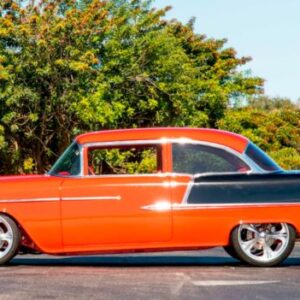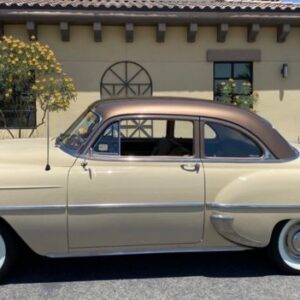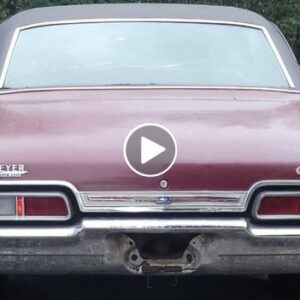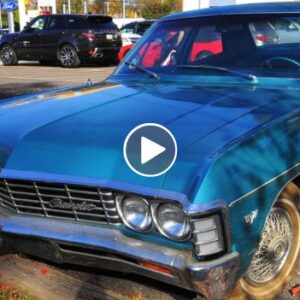The 1976 Toyota Land Cruiser, specifically the FJ40 model, is a rugged and capable off-road vehicle that has gained a reputation for its durability and reliability.
-1686132397x1024.jpg)
1. Cultural Significance
Global Popularity
The Land Cruiser has achieved widespread popularity and recognition worldwide. Its reputation for durability, reliability, and off-road capabilities has made it a preferred choice in various regions, including Africa, Australia, South America, and the Middle East. The Land Cruiser’s presence in different cultures and its ability to tackle challenging terrains have contributed to its cultural significance.
-1686132457x1024.jpg)
Off-Road Adventure and Exploration
The Land Cruiser has become synonymous with off-road adventure and exploration. Its robust design and exceptional off-road capabilities have made it an iconic vehicle for outdoor enthusiasts, adventurers, and those seeking to explore remote and rugged landscapes. The Land Cruiser has been associated with exploration, safaris, overland expeditions, and journeys to remote areas, making it a symbol of adventure and discovery.
-1686132489x1024.jpg)
Longevity and Resilience
The Land Cruiser’s reputation for longevity and resilience has further contributed to its cultural significance. The model’s ability to withstand harsh conditions, challenging terrains, and demanding environments has earned it respect and admiration. Its durable construction and mechanical reliability have made the Land Cruiser a trusted companion in challenging situations, including humanitarian missions, remote work, and disaster relief efforts.
-1686132511x1024.jpg)
Classic and Vintage Appeal
The 1976 Land Cruiser has gained popularity as a classic and vintage vehicle. Its timeless design, rugged aesthetics, and robust build quality have made it highly sought after among car collectors, enthusiasts, and restorers. Many individuals and communities value the Land Cruiser for its nostalgic charm, connection to automotive history, and its representation of a bygone era of rugged utility vehicles.
Iconic Status
The Land Cruiser, including the 1976 model, has achieved an iconic status within the automotive industry and popular culture. Its distinctive design, off-road capabilities, and longevity have made it an enduring symbol of reliability, strength, and adventure. The Land Cruiser’s presence in movies, television shows, and documentaries has further solidified its cultural significance and its association with exploration and adventure.
Cultural Adaptation
The Land Cruiser has been adapted and modified to suit specific cultural and regional needs. For instance, in many African countries, Land Cruisers have been customized for various purposes such as safari tours, wildlife conservation, and transportation in rural areas. These adaptations reflect the Land Cruiser’s ability to adapt to local conditions and its integration into diverse cultural contexts
2. Design
Exterior
The Land Cruiser featured a boxy and angular design that emphasized its off-road capability. It had a classic and timeless appearance that has become synonymous with the Land Cruiser brand. The body was made of durable steel, and it had a relatively short wheelbase, contributing to its maneuverability in off-road situations.
Front Fascia
The front end of the 1976 Land Cruiser had a straightforward and functional design. It featured a horizontally oriented grille with vertical slats and a prominent Toyota emblem in the center. The grille was flanked by round headlights, giving the Land Cruiser a distinctive and recognizable face.
Removable Doors
One unique aspect of the Land Cruiser’s design was its removable doors. This feature allowed for open-air driving and easy access to the cabin. The doors were made of steel and had a relatively simple construction, with roll-up windows and manual door handles.
-1686132697.jpg)
Hardtop and Soft Top
The Land Cruiser came with a removable hardtop, providing protection from the elements and a more enclosed cabin. However, there were also options for a soft top, allowing for an open-top driving experience.
Wheel Options
The Land Cruiser typically came with steel wheels, which were durable and well-suited for off-road use. Some models featured hubcaps, while others had exposed steel rims. The Land Cruiser could also accommodate larger aftermarket wheels and tires for enhanced off-road performance.
-1686132726x1024.jpg)
Body Configurations
The Land Cruiser was available in various body configurations, including a short-wheelbase version with two doors and a longer-wheelbase version with two doors and a rear jump seat. The rear jump seat allowed for additional seating capacity.
Colors
The Land Cruiser was offered in a range of colors, including traditional colors like white, beige, and green. However, other vibrant colors such as blue, red, and yellow were also available, adding to the vehicle’s visual appeal.
-1686132753x1024.jpg)
Overall Aesthetic
The design of the 1976 Land Cruiser blended ruggedness with simplicity and functionality. Its boxy shape and minimalistic styling cues contributed to its iconic and timeless look, which has remained popular among enthusiasts and collectors.
-1686132966x1024.jpg)
3. Performance
Off-Road Capabilities
The Land Cruiser’s performance off-road is where it truly shines. Its robust construction, high ground clearance, and solid axle suspension allowed it to navigate challenging terrains with relative ease. The Land Cruiser featured a part-time four-wheel-drive system, enabling drivers to engage or disengage the front axle for improved fuel efficiency on paved roads. The two-speed transfer case with a low range allowed for enhanced torque and control in demanding off-road situations.
-1686132780x1024.jpg)
Towing and Hauling
The Land Cruiser had a decent towing capacity for its time. With its torquey engine and rugged construction, it was capable of hauling moderate loads and towing trailers or equipment when needed.
Fuel Efficiency
The fuel efficiency of the 1976 Land Cruiser was moderate at best. Its larger engine and rugged design meant that it consumed more fuel compared to smaller, more economical vehicles. However, it’s important to consider that fuel efficiency was not a primary concern for vehicles of that era, especially those designed for off-road use.
Transmission Options
The Land Cruiser typically came with a 4-speed manual transmission, offering drivers full control over gear selection. Some variations may have been equipped with a 3-speed automatic transmission, providing a more relaxed driving experience.
4. Engine
Engine Type
The 2F engine was an inline-six, naturally aspirated gasoline engine. It featured six cylinders arranged in a straight line, providing a smooth power delivery and balanced performance.
Displacement
The engine had a displacement of 4.2 liters, which is equivalent to approximately 4,230 cubic centimeters (cc). The displacement refers to the total volume swept by all the pistons in the engine during one complete cycle.
Configuration
The 2F engine had an overhead valve (OHV) design, also known as pushrod or I-head configuration. This means that the engine had the valves located in the cylinder block, and the valve actuation was done by pushrods and rocker arms.
Power Output
The 2F engine produced around 135 horsepower and generated approximately 210 lb-ft of torque. The power output was measured at the engine’s crankshaft and provided the necessary power for both on-road and off-road driving.
-1686132871x1024.jpg)
Fuel System
The engine utilized a carburetor for fuel delivery. A carburetor mixes fuel and air in the proper ratio and delivers it to the engine cylinders for combustion. Carbureted engines were commonly used during that era.
Cooling System
The 2F engine featured a water-cooling system. It used coolant (a mixture of water and antifreeze) to absorb heat generated during the combustion process and maintain optimal operating temperatures.
-1686132895x1024.jpg)
Lubrication System
The engine had a full-pressure lubrication system. This means that oil was pumped under pressure to critical engine components, such as bearings and pistons, to reduce friction, dissipate heat, and provide lubrication.
Ignition System
The 2F engine utilized a traditional distributor-based ignition system. The distributor, driven by the engine’s camshaft, distributed high-voltage electricity to the spark plugs at the appropriate timing, ensuring combustion in each cylinder.





